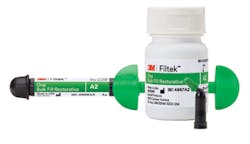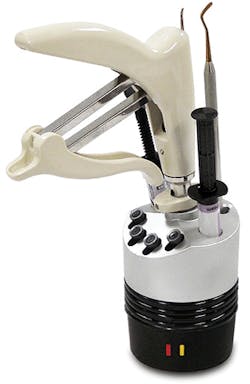Pearls for Your Practice: Bulk-fill composite, warmer, impression material
3M Filtek One bulk-fill composite
Since there is a dental school about five miles from my office in San Antonio, I usually have a few dental students shadowing me and hanging out at my office over the summer. This summer, a dental student and I were talking about what things I do now that are the same as I was taught in dental school. Quickly I was able to come up with local anesthesia and sedation, but after that I struggled. Almost nothing I do today is what I was taught in dental school. He asked about posterior resin composites and I laughed. Almost every part of my posterior resin composite technique is different from what I was taught in school. Bulk-fill composites are a big part of that.
Bulk-fill composites have so many advantages over traditional incrementally filled composites. With traditional universal composites, we could predictably cure only 2 mm increments of material. With increments any larger, the material at the bottom of the increment would be at risk of not fully curing, and polymerization shrinkage stress would increase. This made for some tedious procedures involving multiple steps, each with an opportunity to introduce error or contamination. With bulk-fill composites, we can eliminate steps, saving time and frustration and increasing profit.
Many of the early bulk-fill materials were gray and translucent, giving our final restorations less-than-desirable esthetics. While these restorations were acceptable in the posterior for many clinicians and patients, manufacturers should strive to produce more esthetic bulk-fill materials. 3M Oral Care has created Filtek One, which is what I consider the best-looking bulk-fill resin composite on the market today.
While Filtek One is still more translucent than body shades of überpopular Filtek Supreme Ultra, it blends very well and has much less translucency than its previous iteration. I still feel that bulk-fill materials are only for posterior applications, but Filtek One has significantly reduced the esthetic gap.
Filtek One can be used in increments of 5 mm or less for interproximal restorations. In those situations, cure from the occlusal for 10 seconds, remove the interproximal ring, bend back the matrix, and cure from both the buccal and lingual for 10 seconds. For occlusal restorations, 3M Oral Care recommends increments up to 4 mm in depth.
When using any bulk-fill material, a quality curing light is vital. There are many great options on the market, including Elipar DeepCure-S (3M Oral Care), which was previously featured in Pearls for Your Practice. No matter what curing light you use, make sure its output is greater than 1,000 mW/cm2 for success with bulk-fill materials.
Filtek One is available in five shades. Obviously, five is significantly less than the variety of shades and translucencies you are accustomed to with universal composites, so keep in mind that Filtek One is for posterior applications. Five shades are more than enough. Let’s be honest here—it’s probably four shades too many. In reality, most of us can place A2 in every posterior restoration we do and have a great match the majority of the time.
Bulk-fill posterior composites have changed the way I practice everyday dentistry. As these materials enter their second and third generations, their downsides are decreasing significantly. If you have been holding out on bulk-fill materials, now may be the time to jump in. Take the plunge with Filtek One. I think you will enjoy it. Line-shot triple into the power alley for 3M Oral Care!
Calset Warmer by AdDent Inc.
I have a vivid memory of a particular lesson we had in dental school. Our group’s operative dentistry instructor, Dr. Overton, would commonly have lunchtime sessions in which he would dive into a detailed breakdown of a certain technique or aspect of operative dentistry. One day, he reviewed the concept of heating resin composite to decrease its viscosity and increase its flow. It made the universal composite flow like flowable composite!
You might be thinking, “Why not just use flowable, dummy?” That’s a good question that deserves a good explanation. Not to throw shade on anyone who places flowable composite in the floor of preparations, but there are some concerns about using flowable that way. Compared to universal resin composites, flowable composites have greater polymerization shrinkage and inferior mechanical properties due to their lower filler percentage. Being able to get the great properties of universal composite but with a less viscous delivery was awesome. It was like having the best of both worlds.
Heating composite sounds simple enough, but the way we had to do it back then was cumbersome. Using a hot water bath (like we would use for border molding complete dentures) wasn’t exactly convenient. We would put our composite compules in little baggies and submerge them in the hot water. When it was time to fill, we had to retrieve the compules from the bath, remove them from the baggie, dry them off, and hope that we did it all fast enough so that the composite hadn’t cooled off yet. It wasn’t exactly a smooth operation. The Calset Warmer by AdDent Inc. has changed everything.
The Calset Warmer is a small appliance the size of a baseball that sits on your operatory countertop and plugs in via a small AC adapter. This warmer has three different heat settings: 98 degrees, 130 degrees, and 155 degrees. The best setting to heat composite is 155 degrees. The other settings can be used to warm local anesthetic or porcelain veneers.
One great feature of the Calset Warmer is the different tray options that can be placed atop the heating element to customize it to your needs. There are seven different tray options. The trays have slots for loaded composite guns, compules, composite syringes, instruments, anesthetic, and veneers. A quick glance through the AdDent catalog or website will give you an idea of all of your options.
The Calset Warmer takes around 15 minutes to reach 155 degrees. Once heated, it can warm a compule of composite within three minutes. It won’t hurt your Calset Warmer or your composite to leave composite on the warmer all day long, so your assistant can turn on the warmer first thing in the morning and just restock composite throughout the day. That is incredibly convenient.
Once you try warming your composite, you will immediately notice a difference in viscosity and flow. It takes a little practice to learn how to control and shape the heated resin, but once you get past the learning curve, the results are great. You will see a decrease in voids and an increase in marginal seal—both great results! Opposite-field double for AdDent!
Thermo Clone VPS impression material by Ultradent Products Inc.
I love digital dentistry. I use my digital scanner all the time. But despite all of Silicon Valley’s efforts, impression material is still a necessary supply in the dental office. Sometimes it’s for a deep subgingival margin on an indirect restoration. Sometimes it’s for a removable prosthetic. Other times, it’s for a full-arch implant restoration.
When choosing an impression material system, there are a few things I look for. First off, I need something that has lots of options. I need fast-set and regular-set options. I need different consistencies. And I like to have a putty option. In addition to a full suite of options, I need an impression material that is accurate and that works well in the demanding environment we work in each day. Thermo Clone VPS by Ultradent Products Inc. is a great choice developed with all of these considerations in mind.
Thermo Clone VPS is available in a full suite of options for almost any need—with super light, light, medium, and heavy-body options. The light, medium, and heavy-body impression materials are all available in regular and fast-set options. The super light consistency is available only in a fast-set option, which makes sense. Thermo Clone is also available in a VPS putty option, as well as in bulk cartridges for automatic mixing machines. Ultradent even offers a Thermo Clone bite registration material! All the bases are covered.
Hydrophilicity is a term that gets thrown around often with impression material. The real truth is that none of these materials are absolutely hydrophilic. Some are just less hydrophobic than others. Thermo Clone VPS does have a great contact angle, among the best on the market. Thermo Clone VPS is thixotropic, which allows it to flow into the sulcus while being syringed, which gives us a great shot at a clear margin.
One interesting feature of Thermo Clone is its temperature sensitivity. As the temperature rises, Thermo Clone sets faster. Once the impression material is in the mouth, the setting reaction happens at a faster rate. We get a good working time outside the mouth, but once the tray is in place in the mouth, it almost seems as if Thermo Clone knows that it’s time to begin setting. That is a really nice feature!
I have tried Thermo Clone VPS for indirect restorations, removable prosthetic impressions, and full-arch implant impressions. It has worked well in all those scenarios. I found it to be easy to work with and readable. Ordering is quick and easy because it comes direct from Ultradent, where I already order plenty of other materials. Line-drive single up the middle for Thermo Clone VPS!
About the Author
Joshua Austin, DDS, MAGD
Joshua Austin, DDS, MAGD, is a graduate and former faculty member of the University of Texas Health Science Center at San Antonio School of Dentistry. Author of Dental Economics’ Pearls for Your Practice column, Dr. Austin lectures nationally on products, dental technology, online reputation management, and social media. He maintains a full-time restorative dentistry private practice in San Antonio, Texas. You may contact Dr. Austin at [email protected].
Updated June 21, 2023



